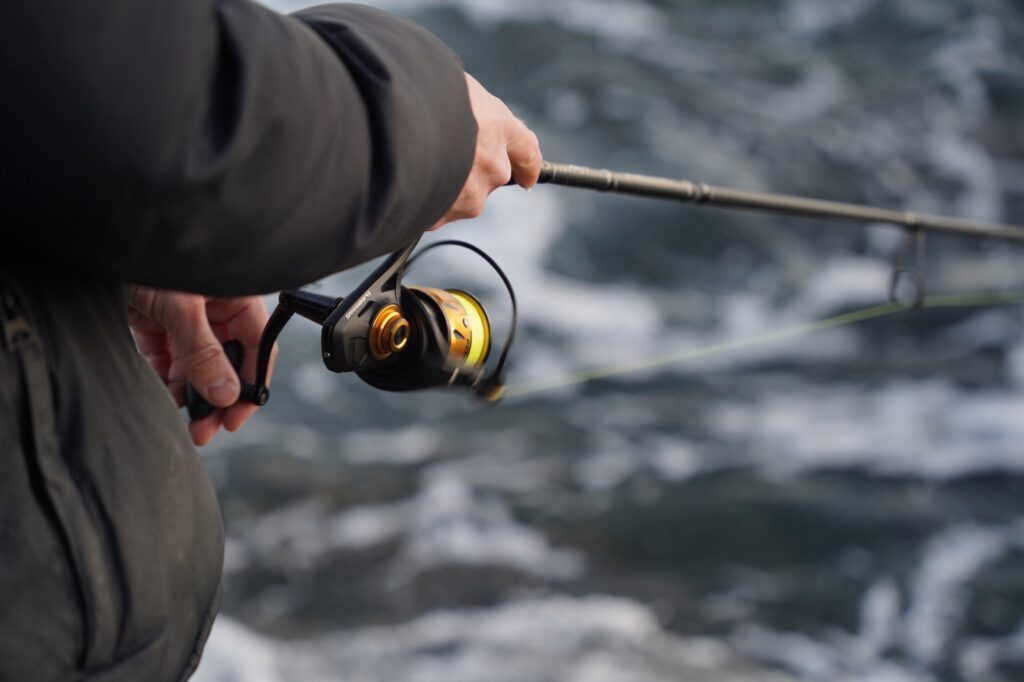
The best bass rods | Finding your next stick
The most common bass fishing setup among dedicated bass anglers in the UK consists of an 8ft rod capable of casting up to 35g. This is typically paired with a reel in the 3000 size range. Such a setup is light enough to cast modern bass lures effectively.
However, it’s essential to consider where you’ll be fishing and the type of lures you’ll be using, as this will affect the ideal rod length, casting weight, and action. A wide variety of rods are marketed as ‘lure rods’ or ‘spinning rods’, making it a bit of a minefield. Some want a fast-action Japanese rod casting 28g – others want something they can beat up on holiday with the kids…
Let’s look at a few of our favourite bass rods in no particular order, along with what types of lures and ground they are most suited for.
Fishmag is reader-supported and earns commissions from affiliate sales, such as from amazon.

Bass rods worth considering
6. Penn Squadron III Labrax
A bass rod that does everything for around £60
Most UK sea anglers are looking for strong and cheap rods. They want it to do everything from flinging feathers to bottom fishing. Some of the mackerel rods we recommend can do those things. These bass rods cannot.
When looking at spending under £100, there is a much higher chance the rod may be rated incorrectly. This means they will cast poorly when you use modern bass lures weighing 20g. The Penn Squadron is a reasonably priced rod that is genuinely suitable for lightweight modern lure fishing. This is an excellent option if you are looking for an entry point to bass fishing with single lures.
View Penn Squadron on veals.
View alternative (heavier) Penn combo on amazon

We have tested the Penn Squadron II and think they’re great for the price.
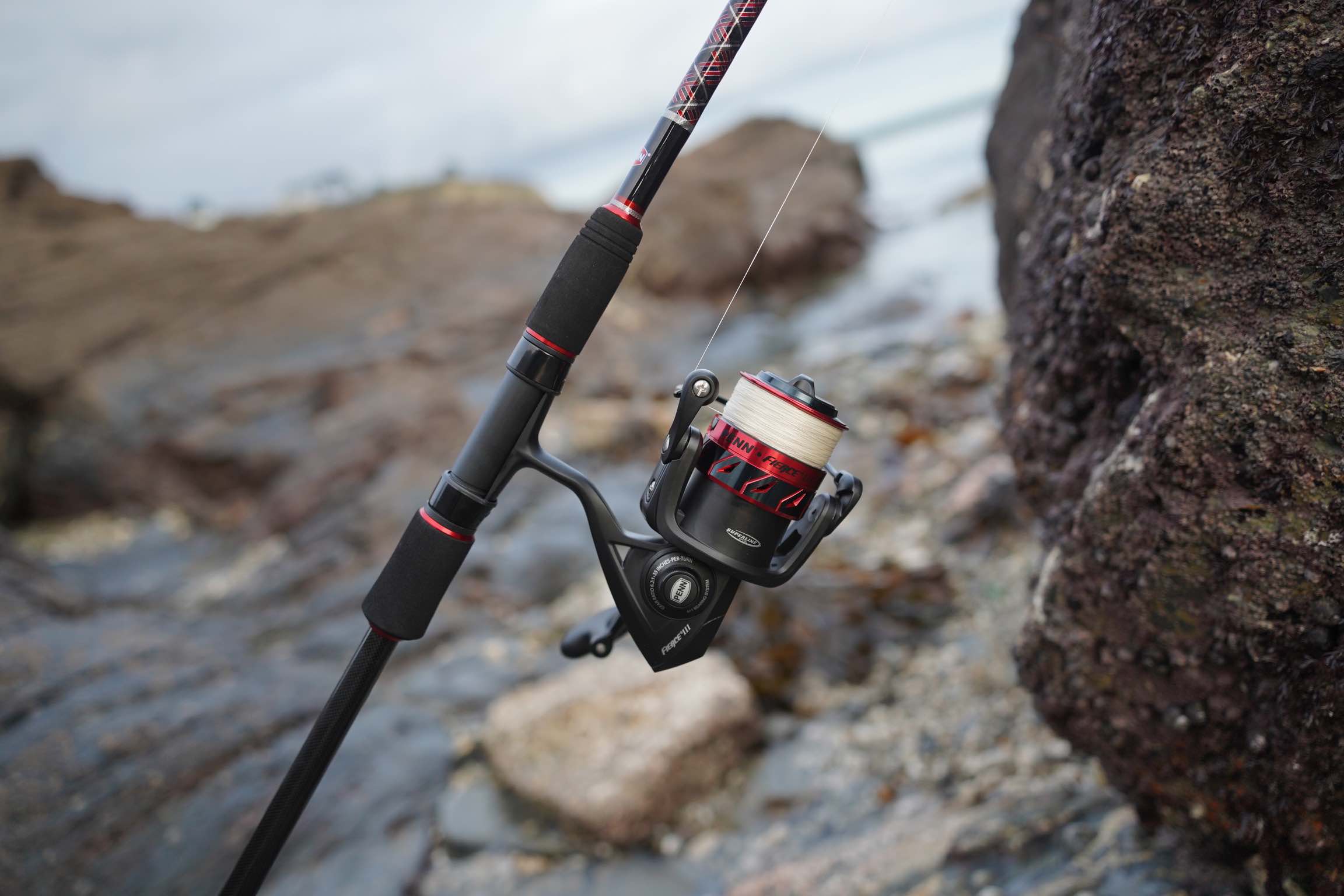
Another perk of this rod is that it’s more sturdy and has a slightly thicker blank than most bass rods. This makes it harder for beginners to snap, so we used it a lot when guiding families. This would be a fantastic rod for a traditional angler who likes bait fishing and using dexter wedges but wants to try out the lighter side of fishing. It’s not crazy light, but it’s light enough…

5. Heavier, 10ft bass rods that can still cast 25g lures
Best for very exposed coastlines & generalists
Bass rods can be between 7-10ft and cast between 21-50g or just under one to two ounces. Shorter and lighter rods are ideal in calm conditions where you can get close to the water. This is because you don’t need any extra length to help you steer fish away from rocks. An 8′ rod that casts one ounce or about 25g is perfect for those British summertime conditions. However, on more rugged coasts or in rougher seas, a 9ft rod that casts 35g-40g is superior for most people. But what if you want to go longer or a bit heavier?
Many people don’t realise that a setup’s ability to cast light bass lures largely depends on the line. With top-end braid, you can cast 10g lures a fair distance on surprisingly heavy rods. If you are fishing on very rugged ground, or you like to use ledgering rigs or mackerel feathers in addition to lures, you could look at heavier lure rods. Rods rated to 80g can still work well with 30g lures if you use nice braid.
Exceptional examples: the higher-end upgrade on the famous HTO Nebula – the Labrax Special or the Japanese Tailwalk in 10ft.

A rod rated to 80g of 10ft in length is only useful for bass fishing with lures when paired with very good braid – the £30-40 stuff. It will be heavy in your hand – like bass fishing in the 90s and early 2000s. But – this setup allows you to fish in the wind, cast miles over white water, and tackle big fish around heavy structure.
It is an excellent rod for the generalist who lives somewhere with an open or exposed coast, and it pairs beautifully with the Daiwa Ninja reel, as seen above.
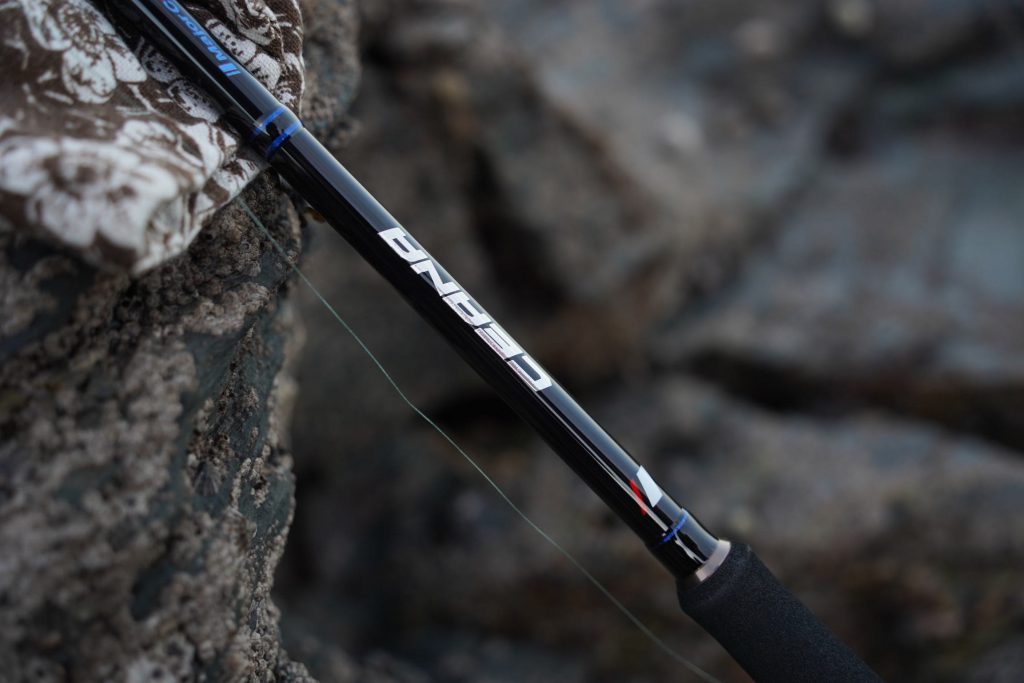
4. Major Craft’s EU Range
The best Japanese bass rods for under £150?
In Japan, Major Craft is considered an upstart brand that came in and started making cheaper rods at the same quality as competitors. This is a little strange because, from a British perspective, a £100 rod is generally considered high-end. In Japan, the attention to detail and pursuit of excellence is quite extreme.
Major Craft knows that the UK fishing market is wildly different from theirs. People spend less cash on gear here so they have released a rod that people in the UK are willing to pay for. It still resembles many aspects of the quality of their range of rods designed for Japan but cuts back on all the frills. The reel seat, for instance, is no nonsense, nothing fancy. It pairs beautifully with the Daiwa Legalis 4000 (in 9ft 6′ length) below and loads very nicely, flinging light lures miles when paired with a decent braid.
View on veals.


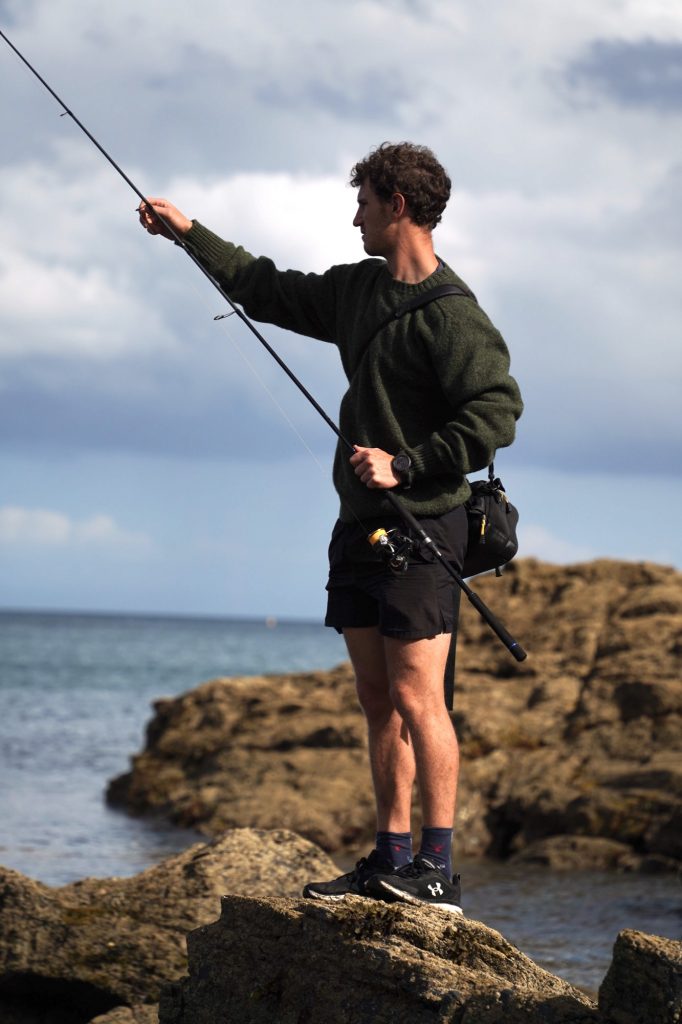
When the crumbs fall from the Japanese fishing tackle table, we should eat them. These rods are in a different realm of quality to most lure rods you can buy in the UK. Major Craft Rods famously makes some of the best rod blanks in the world and sells them with Fuji guides. This provides an insane fishing experience. While the Ceana we used doesn’t offer the same sensitivity as £150+ rods (and it’s noticeably worse), it is much better than most other rods at its price point. We haven’t tested the Solpara due to the sheer number of rods, but we also look forward to trying that rod.
3. HTO Nebula Travel
Probably the best bass travel rod we’ve used
HTO is a UK-based brand, and my understanding is that they aim to create affordable fishing tackle inspired by high-end Japanese designs. Each nebula blank is from Japanese carbon. The rods have been hugely successful, and we specifically recommend the travel version if you can get hold of one.
HTO has a level up from the Nebula that is quite a bit pricier and has a higher build quality. Available here.
View the 10-36g Nebular and 12-42g and the heavier 56g version. Travel version to 35g here.
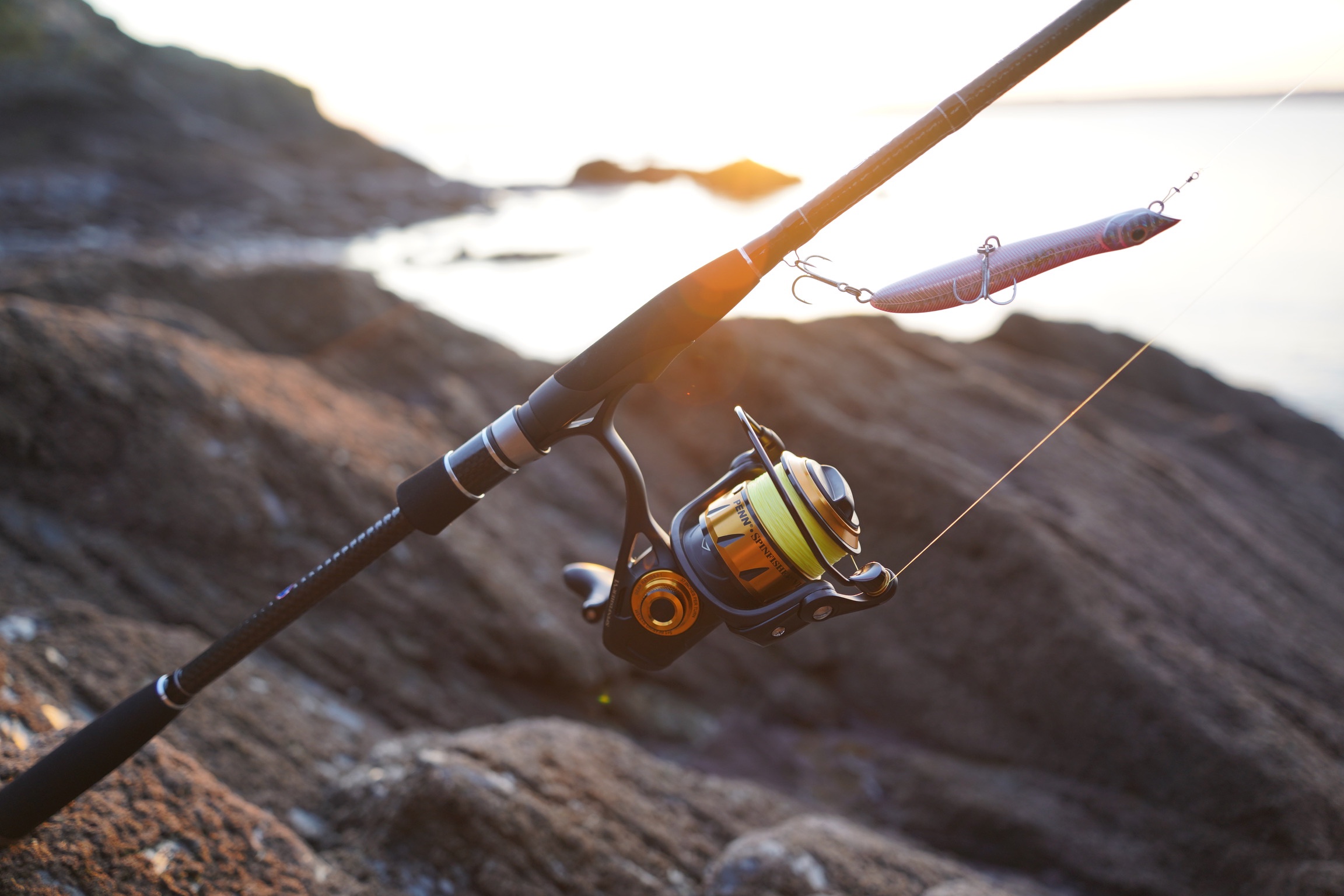
The Nebula’s are light, thin and still powerful, with a fast action. Shaking the rod, it feels relatively stiff until it loads with energy when you cast or hook a fish.
Fuji guides. Fuji Reel Seat support. This is undoubtedly in the high-end rod category, competing with rods worth around £200.

Which Nebula should I buy?
The Nebula comes in several sizes, starting at 6ft 11” casting 5-22g – great for kayak fishing, boat fishing, or perch fishing on treelined banks. At the other end, you have a 9ft 10” model casting up to 56g. FISHMAG generally recommends the 8’0” to the 9’6” models, casting a maximum of either 30g or 42g for anglers fishing very rough coastlines with bigger bass lures that need to be cast in wind. About 9ft is widely considered the best distance to casting accuracy and manoeuvrability trade-off by UK bass anglers.

Note that the travel rod behaves like a lighter rod than the two-piece Nebula at the same casting weight (up to 35g). For many, this will prove advantageous.
The Nebula sells out pretty fast so is sometimes hard to get hold of. If you’re looking for the best travel bass rod, this is the best option we’re aware of in the UK right now.

2. Tailwalk Hi-Tide SSD 90MH
Best bass rods for sheltered rock marks and soft plastic work
I use the lighter Tailwalk for much of my lure fishing. It’s particularly handy for whacking small jigs to the horizon. I use a lighter version of the rod rated to 20g because I often fish in sheltered coves. On an exposed open coast, sometimes you want to be able to whack a 35g lure in the wind. However, the 35g version will be much better for most anglers as it’s more versatile and useful in rougher conditions. The 50g version is suitable for those using the rod with the largest plugs and also for winter pike fishing or fishing overseas for larger species. These are seriously premium bass fishing rods. I recommend pairing it with a Daiwa or Shimano reel. I find the Penn Spinfisher a bit heavy on this rod, but it’s still ok.
The Tailwalks seem to be out of stock and I’m not sure if they’re coming back in again, but the APIA rods from Japan offer the same kind of quality and lightness. These rods cast light soft plastics beautifully, they are crisp and all-round stunning rods to fish with. They elevate the experience quite a bit, and do offer enhanced bite sensitivity if you’re looking to justify the admittedly unnecessary luxury!
Currently out of stock at veals. The Tailwalk Rize Shooter SSD S96ml offers a radical alternative for casting larger metal jigs and plugs from the shore. A fantastic rod for an angler that targets pike or fishes on particularly exposed, rugged coasts and needs to be able to whack 40g jigs.
The Hightide is however available here on amazon.


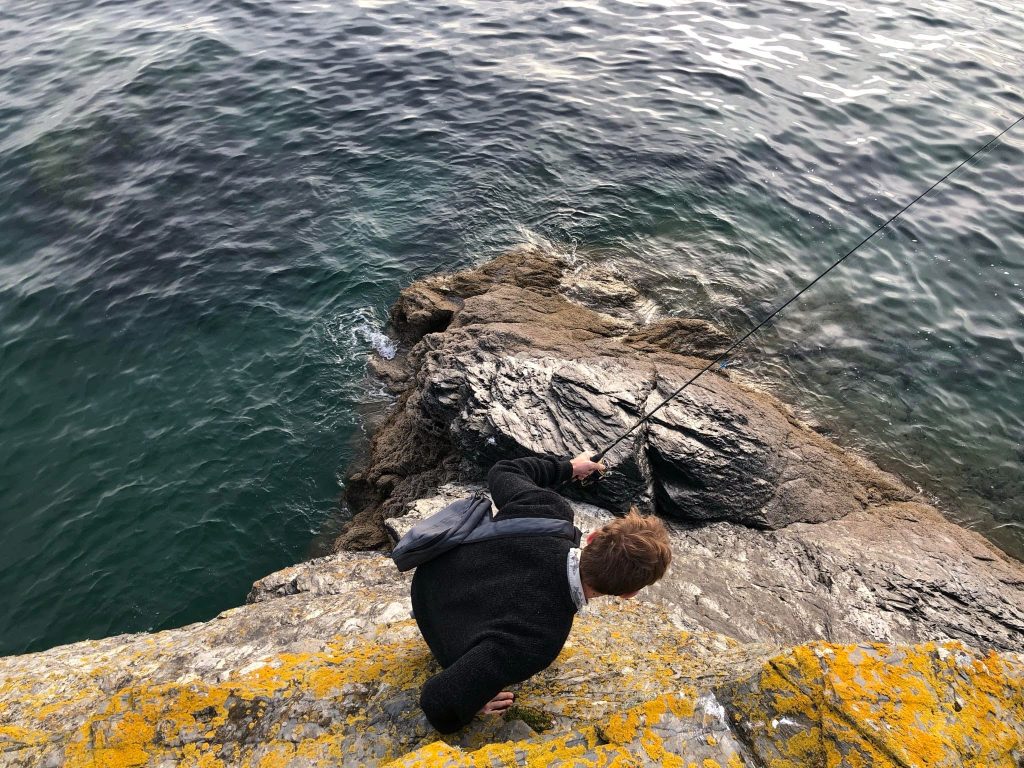
1. Tenryu Injection SP82MH 2ES
Super high end bass rods
Tenryu manufactures premium bass rods. The quality of one of these rods doesn’t equate to twice the quality of a £225 rod from Tailwalk. The difference won’t be that significant. Both rods use Fuji guides. Both rods have excellent blanks. The value of the Tenryu rod lies partly in its rugged feel and thickness. This quality reassures anglers. The fear of snapping your new fishing rod in half is always present. Breaking a high-end item is painful. It feels more comfortable to purchase something sturdy. Something with a ‘hand it down to your kids’ kind of quality. The Tenryu rod offers this quality.
We haven’t yet used these rods, so we can’t provide an in-depth review. However, we must mention them. It’s important to know what kind of rods are available if you’re seeking the best in the market.
View on veals.

Longer vs shorter lure rods
- 6ft lure rods are useful for bass fishing from very small boats
- 7ft lure rods give you a lot of control over your lures and are good for fishing close to the water
- 8ft lure rods are often considered the best bass rod for calmer waters
- 9ft lure rods are seen as the best all-round bass rod by many anglers
- 10ft lure rods are superior in rough seas because you can fish further from the water
Longer rods have less manoeuvrability in short-range fish-fighting. But, they cast much further than shorter rods. Shorter rods also give you much more control over your lure’s movement. Most bass anglers settle on a rod between 8-9ft, but it depends on your preference.

What casting weight should my lure rod be rated to?
The most crucial information is not to try casting weights beyond the upper limit of the rod unless you think the rod is mislabelled. The most common amateur mistake would be to buy a rod that’s way too heavy – say a spinning rod that casts 3oz – and then try to fish with modern bass lures that weigh <28g. It’s possible to fish like this, but you will have a limited casting range.
When fishing with plugs that have fairly aggressive actions, you will feel the vibration and movement running up the rod. You don’t want your rod to be bending into the lure too much, or else you will get reduced bite sensitivity. It is beneficial to fish with plugs that your rod can cast comfortably. E.g. 21g may be better for a rod rated to 28g.
It’s quite easy to confuse power with action. Power is measured from light to heavy. It correlates with how much weight the rod can cast. Action on the other hand is measured from slow to fast. When you hold and shake a rod, a fast action rod returns to being straight more quickly. A fast action also means the rod bends more towards the tip. A slow action rod bends further down in the rod.

What’s the best rod action for bass?
Faster actions bend more towards the tip, providing superior sensitivity. Slower actions bend more towards the centre and butt of the rod. This is better for not pulling hooks, such as from the mouths of mullet. If you are fishing with unweighted soft plastics, a slower action rod will cast the lure further. However, bites won’t be as detectable in the tip of the rod. The fishing will be slightly less visual. Most consider these differences minor.
FAST ACTION
Rod holds form fishing with lures that create more drag – like plugs. More sensitive. Can feel stiff and more prone to snap offs and hook pulls.
MEDIUM ACTION
A happy medium for those that like to fish with one rod, which is most people! This is what I would recommend for anglers that use a mixture of hard and soft lures.
SLOW ACTION
Great for soft / lighter lures as it helps them cast further even at lower weights. Slow action rods load better with lighter lures. Less sensitivity in terms of tip movement, but vibrations will be the same.
Some rods are labelled L, ML, M, MH. This tends to refer to the power of the rod rather than the action. Action and power aren’t very important to the majority of anglers, and many won’t even notice the difference.
PE Ratio (also not important if you’re using 12-20lb braid)
Some rods come labelled with a PE Rating or Line Rating. Line rating refers to the strength of monofilament or fluorocarbon line the manufacturers recommend you use with the rod. PE rating refers to the recommended PE rating of braided lines.
The vast majority of bass anglers fish with 20lb braid. This is fine for pretty much any bass rod, so in my opinion, this can be ignored. Higher quality braids from better brands will be better to fish with on any modern lure rod.
Bait fishing vs Bass Lure Rods
Beachcasters provide a lot of leverage, making them useful for pulling the largest species away from structures. For instance, they can help get a conger away from its hole. Beach casters are ideal for anglers targeting large fish species over 10lb. They are also suitable for those who enjoy bottom fishing with traditional baits. Fishing an estuary or beach mark at night can be relaxing. This might be even more so than spinning.
If you are mostly after predators like bass, mackerel and pollack and you enjoy a more active, light weight and fast paced fishing style, you will be looking at spinning rods.
Your rod needs to be the right size for your reel. A 7ft rod balances with a size 3000 reel and a 9ft rod is best off with a 4000 size reel.
The power of balanced gear
A balanced kit ensures you feel in control – your line won’t snap off, your reel won’t get tangled, and you’ll cast a lot further. When you play fish, the rod and drag work together to absorb the fish’s power. This puts less strain on your line and knots, preventing snap offs. For occasional anglers, a pre-made kit like this one simplifies fishing. You can purchase it and immediately get out on the water. If you desire a very high-end spinning rod, consider rods targeted at bass anglers.
It can be surprising when somebody with a 7ft rod and a 12g lure can cast further than you can with a 12ft beach caster and a 6oz weight, and catches more mackerel even though you have on four hooks and they have one. Yet this happens all the time.
In a feeding frenzy, a heavy spinning rod with mackerel feathers is of course going to be a more productive rod, but when finesse is required, you’ll have the edge with lighter gear.
The beauty of spinning with light rods is the ability to fine-tune your approach and present lures in a way that makes them realistic to fish. It’s also just incredibly fun using lighter gear!
The difference with lighter bass rods
Light spinning rods offer more control over the depth you fish. This is due to the heightened awareness of your lure’s position in the water, a sensitivity that lighter gear provides. When using a heavy spinning rod or a beach caster, you realise when you’ve hit the bottom as your line goes slack. However, with a super light spinning rod, you can discern the type of weed your lure is bouncing over based on the resistance it generates. Devil’s hair creates a jolty resistance that comes through fairly easily. Kelp is a fixed snag that sways with the current, and light green weed in the water provides a constant weight and resistance. The vibrations they create in the butt of your rod allow you to identify the fish you’ve hooked within seconds. Lightweight lure fishing is an entirely different experience.
Over time, fishing lures have been shrinking to accommodate increasingly lightweight spinning rods. This trend is partly due to improved technology, resulting in rods with fast actions and low casting weights that possess significant strength. Additionally, the drags on reels can now be fine-tuned. This allowing the rod to absorb the optimal amount of energy from the fish. If you fish with an antiquated set up, you’ll find the rod feels clunky. The drags on these reels lack smoothness, exerting more pressure on your line. Consequently, you must fish with heavier lines and, ultimately, heavier lures. This situation is also true for the very low end of the market today. Lighter rods enable you to fish with smaller lures, which most UK fish species are particularly fond of.
Can I use a bass rod for other species?
Bass rods are the most versatile spinning rods you could own because the casting weight is also perfect for sport fishing for perch, pike, wrasse, bigger trout in rivers and even squid.
Further Research
Surf fishing for big bass with Grant Woodgate
Surf fishing for big bass with Samson Lures | Masterclass with Grant Woodgate Few people…
The best braided fishing lines, ranked
The best braided fishing lines, ranked We look at the best braids, from the budget…
The UK’s Best Bass Lures
The UK’s Best Bass Lures Let’s start by looking at the three bass lures that…
The Ideal Lure Fishing Set-Up
Lure fishing set ups, everything you need. In this article, I will recommend specific rods,…
Rock Fishing with Lures
Rock Fishing with Lures You’re sat, perching on a rock below a colony of cormorants….
Lure Fishing UK | Beginners Guide
Lure Fishing UK | Beginners Guide This guide to lure fishing for beginners covers the…





